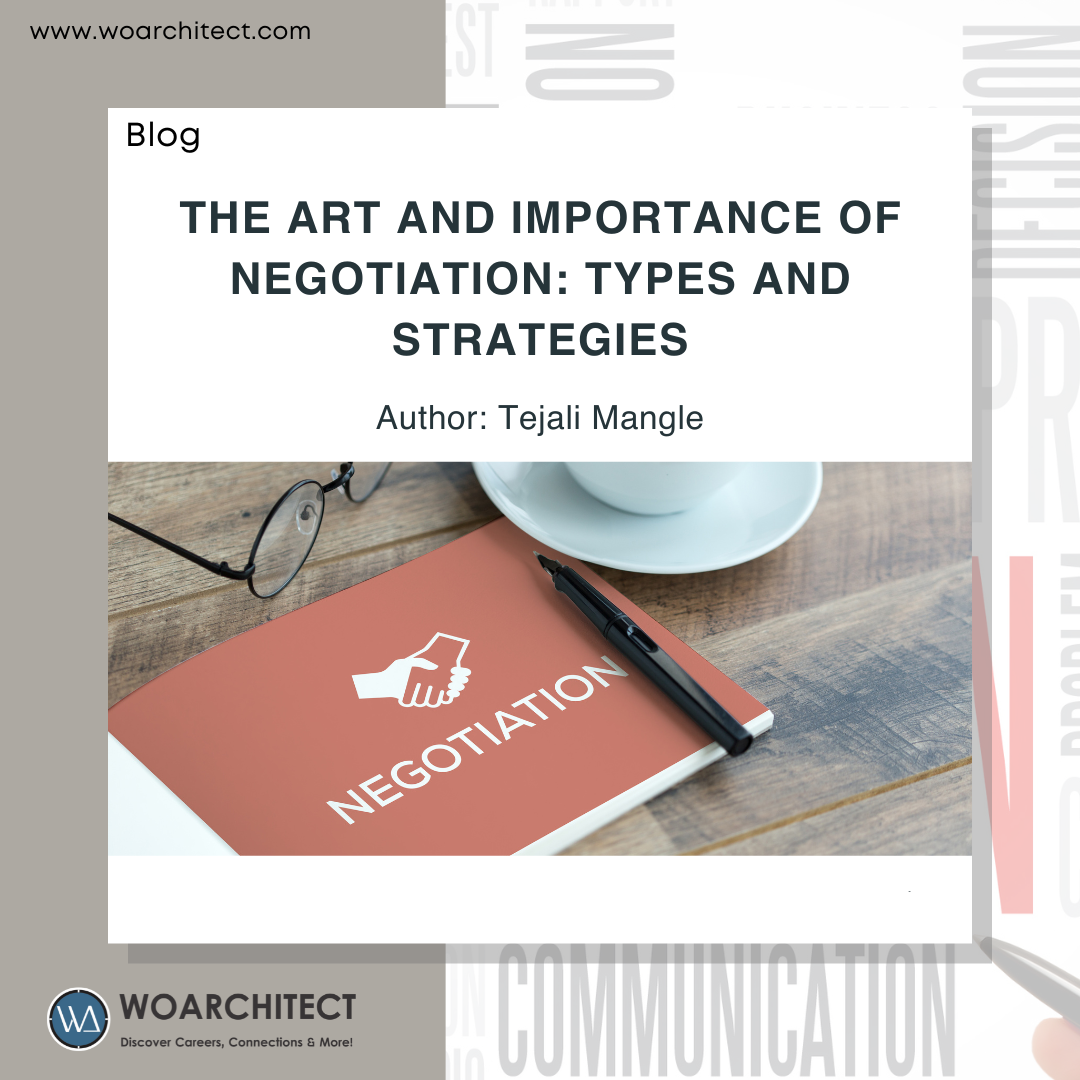
The Art and Importance of Negotiation: Types and Strategies
“Successful negotiation is not about getting to 'yes'; it's about mastering 'no' and understanding what the path to an agreement is” (Buskiewicz & Curotta, 2018, as quoted by Christopher Voss, businessperson & former FBI hostage negotiator). Architects and Planners negotiate at every step of the way. The complexity of the negotiation varies in every case, but the basic elements remain constant (Fisher et al., 1991, p. xix). This could be a salary negotiation with the employer, negotiating with stakeholders in a way to settle on something that works for everyone, land acquisition negotiations, negotiations on creating robust contracts, negotiations with developers while working on a project that is suitable for the city as well as profitable to the developer, etc. Such circumstances require us to have an understanding of making the right decision and the capacity to anticipate unforeseeable concerns before settling for an offer.
Through this paper, my goal is to simplify the concepts and theories of negotiation. This paper will assist the readers primarily for the architectural engineering and construction (AEC) & planning industry in strategizing successful negotiations. Negotiations can be stressful. Most of the time, it is money, opportunity, time, and/or a relationship at stake (Nalebuff & Brandenburger, 2021). This is why, keeping emotions in check is crucial when entering into a meeting, even though it is something we are highly enthusiastic about.
This paper is divided into three main parts:
- WHO are you negotiating with?
- HOW will you strategize negotiations?
- WHY is it important to be able to be successful in negotiating?
Know your Players
Most people do some research before they set a meeting time with their negotiator. It is important to note that you are only dealing with an individual, although individual heads a 10,000 people organization (Dawson, 2001, p. 242). This is because of the personal values and needs of an individual that could still dominate the conversation. Dawson (2001, p. 243) further provides a plan to improve the personal characteristics that could control your conversation with the negotiator.
- Ask tough questions
Asking questions is a process of gathering information on what the negotiator is willing and not willing to settle on. This step will also help you confirm some of your analysis and give you a clear idea to set your goals. The key is to see if you receive consistent answers. You can solve the most difficult problems just by asking the right questions (Dawson, 2001, p. 183). Note that asking questions also make the competitor feel important.
- Be Patient
It is important to not get influenced by the pressure of making a deal work out the same way you planned and to not be pressured with time. Note that getting a ‘no’ as an answer is the beginning of the conversation and not the end. Getting a ‘no’ will help you eliminate choices and define boundaries to enter the negotiation zone (Voss & Raz, 2016, p. 103).
- Courage to ask for more
Instead of walking away from a difficult negotiation, it is important to portray the courage to ask what you want to achieve. Asking for what you want is going to take you far in the game. Use the data that you collected before and during the meeting to support your asks (Gibbings, 2020).
- Be a good listener
Listening carefully is a critical skill. Paying attention to what the person is saying, makes them feel valued. Practicing body language such as leaning forward, taking notes, providing brief feedback, and acknowledging their ideas makes them feel that it is a two-way conversation when in reality it is you trying to gauge as much information as you can from that opportunity (Dawson, 2001, p. 245).
Apart from the personal values that influence negotiations, one of the major other factors that could play a significant role in these interactions is cultural differences. Brett et al. (2011) stated that people with distinct cultural backgrounds vary in their level of trust (as cited by Ferrin & Gillespie, 2010). They added that the ‘level of trust’ refers to the trust in negotiation strategies and not in behavioral patterns. It could be beneficial to understand the culture and the organizational background before entering any meeting to negotiate.
Negotiation Styles
Negotiation styles have a significant impact on bargaining interactions. Some individuals prefer a cooperative style while some are inclined towards using a competitive style (Craver, 2003). Negotiators with a cooperative style tend to be gentler with their interactions and tend to settle for an agreement that benefits everyone. Competitive bargainers are sometimes aggressive in their approach and are always aiming for the highest and best benefit for themselves. While one would think that using only one of these strategies could work best for them, there could be instances when you may choose to pick one over the other, or even a combination of strategies listed below. Ira Asherman (2012, p. 63) notes five (5) basic styles of negotiation:
- Win-Lose (Competitive): Competitive negotiators approach psychologically against their opponents and try to maximize their profits. They tend to minimize sharing information, manipulate opponents, and make minimal concessions (Craver, 2003). Oftentimes, the drive to apply a competitive negotiation style is high when an individual assumes that the opponent is doing the same by sharing limited information (Dawson, 2001, p. 294).
- Lose-Win (Accommodating): The drive to be in an accommodating negotiation strategy could be related to saving important relationships and dignity. These interactions are two-directional, and at times, one could think that they are better off letting this opportunity pass while exploring greater benefits for their organization through a different channel. Accommodating negotiation styles could strengthen business relationships, and sometimes these relationships could turn out to be more beneficial in the future to achieve greater business goals.
- Lose-Lose (Avoiding): In this style of negotiation, the person may not be fully invested in the idea. Thompson and Hrebec (1996) define this type of interaction as “an instance in which people in an inter-dependent decision-making situation prefer one settlement over another but fail to achieve that settlement.” This situation could occur when then both parties have multiple needs with multiple alternatives but not sufficient information to support their needs (Thompson & Hrebec, 1996). This style could also portray passive aggression which is used by people who dislike conflict (Coburn, 2015).
- Win-Win (Collaborative): This style of negotiation is similar to what Craver (2021) defines as cooperative. In this style of negotiation, you aim to create joint gains for all the players involved (Brett et al., 2011). A collaborative style could be used when each party seeks a different outcome through the bargain (Brett et al., 2011). Individuals who often seek collaboration through their bargaining styles are solution driven and are always curious to find more information to attain a win-win solution (Dawson, 2001, p. 295).
- Compromise: One of the greatest skills that one requires to conduct successful negotiation is assertiveness. Compromise in negotiations could occur due to a lack of assertiveness, and not being able to ask for what you want. The compromising style is used when you are pushed for time (Coburn, 2015), and when you believe that any little amount of gain is enough at the given time. But it is important to understand what is it that you could afford to lose.
Negotiation Methods
Negotiation is an acquired art that requires constant and guided practice. This paper notes various guidelines for you to follow toward becoming a successful negotiator. Negotiation is the social process by which the parties involved in achieving the gains are willing to achieve joint gains (Brett et al., 2017). However, joint gains are difficult to achieve since the negotiators are unsuccessful to use the best possible strategies (Thompson, 2014). Below are some strategies that could help you raise your game.
Separate the people from the problem: One must make a note that negotiators are people first who are representing an organization (Fisher et al., 1991, p. 18). It is possible that the opponent may react to your wants and be high on emotions. Even if you are negotiating about something you are passionate about or emotional about, it is important to focus on the business outcomes that we seek through these negotiations (Hughes & Ertel, 2020). Dawson (2001, p. 245) suggests concentrating on the information that is being conveyed by the opponent and not the style or delivery. This could help to keep one’s emotions in control. To be able to understand the conversation deeply, it is useful to be aware of these basic categories (Fisher et al., 1991, p. 22):
- Perception to be able to differentiate between your thinking and the opponents. As Fisher et al. (2001) stated, “...conflict lies not in objective reality, but in people’s heads” (p. 22).
- Recognize emotions, yours, and theirs, during the meeting. If there is anything that makes you feel angry then practice asking a question to yourself, ‘what makes you angry?’. Oftentimes, it is a piece of information, and not the people delivering it.
- Communication is the soul element of negotiation. It works both ways, to be able to explicitly speak what you want, it is crucial to listen to what the opponent says. If you aren’t listening meticulously, it is easier to misinterpret. It could be beneficial if you take notes or add a team member to the meeting to be able to understand the conversation from an unfamiliar perspective (Dawson, 2001, p. 245).
Intentions vs Expectations: Having your intentions and expectations explicitly listed on a notepad before walking into the meeting, will keep the conversation focused and on point. This strategy will also help you be able to invent solutions and alternatives that would benefit everyone. At any point, you sidetrack from the original conversation, having this list in front of you will help you be assertive in your tone (Voss & Raz, 2016, p. 260). Intentions and expectations are two different components of your thought process. What you could afford to lose in order to gain something else that is more important is a great trait to have as a negotiator.
Tell a story: You may master the art of asking what you want, but this could also come out as a threat to many. Most of the time, people are willing to listen to your intentions (your story) behind your ask. As Simon Sinek said, “Goal is to do business with people who believe in ‘why’ you do what you do” (Sinek, 2011). When you tell a story about why you do what you do (Sinek, 2011, p. 42), and how is that it reflects in your negotiation skills. Your story may influence and inspire the opponent to understand the depth of your wants. As Gallo (2014) wrote, “Abstractions are difficult for most people to process. Stories turn abstract concepts into tangible, emotional, and memorable ideas” (p. 57).
Conclusion
We all agree that negotiations can be stressful and could produce a lot of anxiety not just for you but also for the opponents. There could be a few things that you could do to ease the tension in the room by being positive in your tone during the meeting, open to listening actively to the opponents, and selecting a less intimidating space to hold the meeting. The definition of successful negotiation could vary for every individual; therefore, it is important to have your intentions clear on what you want to gain through this conversation. For some people, success could mean making new professional relationships, being able to get your ideas through, making a huge profit, or settling on a creative collaborative idea. Being honest and explicit about your feelings could create a sense of empathy since that could lead to effective communication and interaction (Kinicki, 2021, p. 349).
Successful negotiations are also directly related to ethical intentions. Even though negotiation strategies depend on the manipulative conversations between the parties, one must constantly question if their behavior is influenced by ethical or unethical ideologies. To me, successful negotiations are those conversations when I could continually be aware of my core values being compromised or not. Lastly, ethics in negotiations could go beyond our efforts as Gunia (2019) asks, “Is a keen sense of how to manipulate another person for personal advantage, outside of their awareness, really an “ethical” takeaway?”
About Author
Tejali Mangle, Architect and Planner, currently working as a Planner in Fortworth area, Texas, USA and also perusing her MBA . Tejali is an Urban Designer with focus on public spaces as part of her research and professional work. She enjoys master planning and is intrigued by how spaces beyond architecture shape people's life socially, physically, and mentally. She constantly feels the need to learn more, focus, travel, photograph and document experiences and learnings while continuing to expand her perspective towards providing a qualitative lifestyle to the society.
Instagram handle: tejalimangle
She can be reached and connected via Linkedin
References
Asherman, I. G. (2012). Negotiation At Work. New York: HRD Press.
Brett, J. M., Gunia, B. C., & Teucher, B. M. (2017). Culture and Negotiation Strategy: A Framework for Future Research. Academy of Management Perspectives, 31(4), 288-308.
Buskiewicz, N., & Curotta, H. (2018). Mastering the Art of Negotiation in Advocacy. Retrieved from Advoc8: https://www.advoc8.co/blog/the-subtle-art-of-negotiation-in-advocacy
Coburn, C. (2015). Negotiation Conflict Styles. Retrieved from https://karemmieses.com
Craver, C. B. (2003). Negotiation Styles: The Impact on Bargaining Transactions. Journal of Dispute Resolution. Retrieved from http://ssrn.com/abstract=1003448
Dawson, R. (2001). Secrets of Power Negotiating (Second ed.). Franklin Lakes, New Jersey: Career Press.
Fisher, R., Ury, W., & Patton, B. (1991). Introduction. In B. Patton (Ed.), Getting to YES: Negotiating Agreement Without Getting In (Second ed.). United States: Penguin Books.
Gallo, C. (2014). Talk Like TED. New York: St. Martin's Griffin.
Gibbings, M. (2020). Become a Better, Stronger, and More Confident Negotiator. Harvard Business Review. Retrieved from https://hbr.org/
Gunia, B. C. (2019). Ethics in Negotiation: Causes and Consequences. Academy of Management Perspectives, 3(1), 3-11.
How Great Leaders Inspire Action. (2011). TED. Retrieved from https://www.ted.com/talks/simon_sinek_how_great_leaders_inspire_action/
Hughes, J., & Ertel, D. (2020). What's your negotiation strategy? Harvard Business Review, pp. 76-85.
Kinicki, A. (2021). Making OB work for me. In Organizational Behavior: A practical, Problem-Solving Approach. New York, NY: McGraw-Hill Education.
Nalebuff, B., & Brandenburger, A. (2021). Rethinking Negotiations: A smarter way to split the pie. Harvard Business Review, pp. 110-119. Retrieved from hbsp.harvard.edu
Sinek, S. (2011). Start With Why. New York: Penguin Group.
Thompson, L. (2014). The Mind and Heart of the Negotiator. Upper Saddle River, NJ: Prentice Hall.
Thompson, L., & Hrebec, D. (1996). Lose-Lose Agreements in Interdependent Decision Making. American Psychological Association, 120(3), 396-409.
Voss, C., & Raz, T. (2016). Never Split The Difference: Negotiating As If Your Life Depended On It (First ed.). New York: HarperCollins Publishers, Inc.































